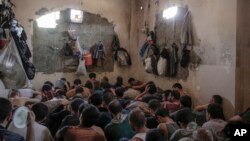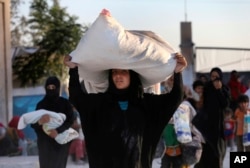As U.S.-backed forces made their final push into the city of Raqqa to liberate what had once been the Syrian capital of the Islamic State's self-declared caliphate, they faced a problem.
Not only were the Syrian Democratic Forces (SDF) holding IS fighters — some captured and some who had surrendered — they were also encountering many Syrians who, for various reasons, had collaborated with or worked for the terror group.
In the end, against their initial instincts, the U.S.-backed forces let many of them go.
"[The SDF] was pressured and convinced by the civil council, the civil leadership, in that part of Syria, who listened to the tribal leaders," said Major General James Jarrard, commander of the special operations joint task force for Operation Inherent Resolve.
Just how many IS followers or collaborators from the areas in and around Raqqa were ultimately freed is unclear — officials with Operation Inherent Resolve have not been able to provide any numbers.
As worrisome as the prospect of their release might sound, coalition officials are not concerned, assuring anyone who asks that the local IS fighters and supporters are not likely to cause trouble.
"A lot of those that were captured that were local Syrians have been turned over to their tribal leadership," according to Jarrard, who briefed reporters last week. "The SDF leadership feels comfortable that the tribal leadership and the tribal code in northeast Syria will make sure that they maintain control of those individuals."
Tracking IS fighters, collaborators
But perhaps more critically, other protections have been put in place.
"What we did do with the SDF, is we did take all of those members and we enrolled them biometricaly, so that we are able to track them into the future," Jarrard said.
The collection of biometric information from those who fought for or worked with Islamic State in Raqqa is just a small part of a much wider effort encompassing other areas once under the terror group's control.
The goal is to make sure those affiliated with IS are not able to go undetected and find ways to unleash terror and havoc, whether in Iraq and Syria or the West.
The collected information commonly includes fingerprints, photos, DNA samples and even retinal scans, and not just from Syria. Iraqi forces and U.S.-backed Kurdish forces in Iraq have also been gathering biometric data.
Some of the biometric information is already available to forces on the ground, who can use hand-held scanners, slightly larger than a big mobile phone, to take readings from suspects to see if they are already in the IS database.
But officials and observers in the United States, Europe and the Middle East acknowledge it is a massive undertaking, and that gaps remain.
"IDPs [internally displaced persons] who end up in camps on the Kurdish side and suspects held by Kurdish authorities are all getting put onto a biometric database," according to Belkis Wille, a senior Human Rights Watch researcher who has spent time in the region.
"On the Iraqi side, I have not seen it happening to the broader population and have not heard about it with regard to ISIS suspect detainees yet, but have heard it talked about many times as in the plans," she added, using an acronym for the terror group.
Iraqi officials told VOA in July that they were "working on the mechanism" for sharing biometric data with their coalition partners, admitting there was no timeline for when a solution might be found.
Overcoming obstacles
The coalition, too, admitted there were obstacles.
"We are working to enable them [Iraqi officials] to better manage biometric information, to re-establish some capability that was here before that no longer is," Canadian Armed Forces Brigadier General D.J. Anderson, then director of the coalition's partner force development liaison team, said at the time.
There are also concerns about ensuring that everyone who might need access to the biometric data can get it, with European officials especially keen on speeding up the process.
"In a world where we see more people traveling with false documents, counterfeit documents, we need to inject much more biometrics," European Union Counterterrorism Coordinator Gilles de Kerchove said during a visit to the U.S. in June.
"I would like to see if fingerprints are collected in Mosul or in Raqqa that it be shared in real time with the border guard at the external border of the European Union," he added.
Interpol, the international police organization with more than 190 member countries, has been trying to help.
Interpol officials say it has shared information on more than 18,000 foreign fighters through its I-24/7 global communications network, some of which includes biometric information. And it is working to increase the amount of biometric data currently available.
Watching for returning foreign fighters
That additional biometric information cannot come soon enough for some European officials, worried about the steady tide of refugees from Syria and Iraq, even though there are no indications that the long-feared wave of returning foreign fighters will ever materialize.
"We have, however, identified an increase in the number of wives and children who are willing to return," said Friedrich Grommes, head of the international terrorism directorate at Germany's Federal Intelligence Service (BND), during a recent visit to Washington.
"This upward trend will probably increase in the months to come," he added.
German officials say they have already used whatever biometric information is available to confirm the identities of family members of foreign fighters who may be seeking entry into Germany.
There are also growing fears some foreign fighters, terrorist operatives and their family members may be getting some sophisticated help.
"We see a lot of relationships between organized crime and terrorism, not ideologically but from old friendships sometimes," said Dutch National Counterterrorism Coordinator Dick Schoof. "Organized crime is a facilitator for weapons, for transport, for fraud documents, for identity theft."
And while most of the more than 5,000 would-be jihadists who left Europe are not expected to attempt a return — a feat made more difficult with a tightening of the Turkish-Syrian border — counterterror officials believe there are plenty of reasons to remain concerned.
"Quantity may not be the story," U.S. National Counterterrorism Director Nicholas Rasmussen said this past July at the Aspen Security Summit.
"If I'm sitting in western Europe in a security service or a law enforcement organization, I'm very, very concerned about even a small number of foreign fighters from my country who come back from the conflict zone with a whole new set of skills, a whole new set of contacts, perhaps even specialized skills that go into areas of mass destruction."












